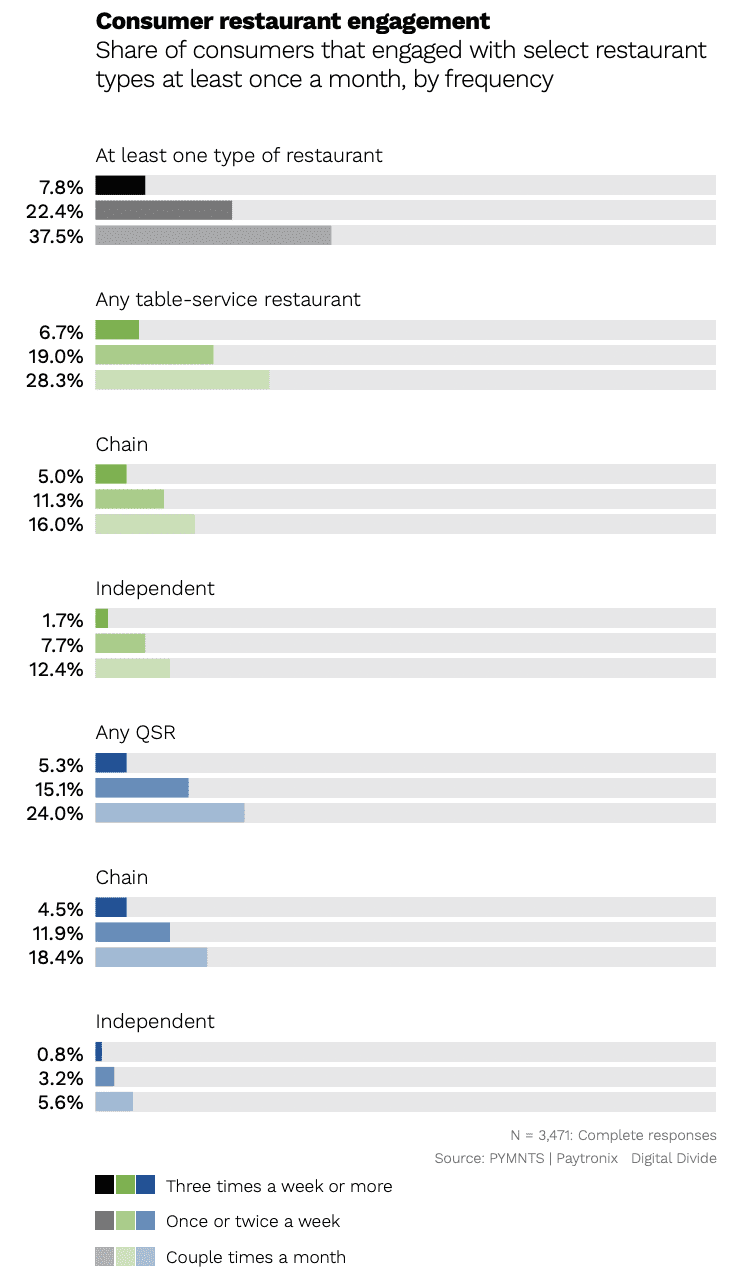Many consumers love dining out, but not all restaurants are able to build the kind of deeper relationships with customers that take their spending to the next level.
While consumers keep returning to chain table-service restaurants, for instance, independent quick service restaurants (QSRs) have more difficulty turning their customers into loyal fans, according to data from PYMNTS’ new study, “Digital Divide: Minding The Loyalty Gap,” created in collaboration with Paytronix.
Get the report: Minding The Loyalty Gap
The study, which featured the results of a census-balanced survey of more than 2,000 United States adults, found that 8% of customers are restaurant super fans, visiting at least one type of restaurants three times a week or more. Chain table-service restaurants were the most popular pick for these diners, with 5% of all consumers visiting such restaurants at least a few times a week, closely followed by chain QSRs. Meanwhile, just 2% of consumers visit independent table-service restaurants as often, and less than 1% do so for independent QSRs.
 Given the significant role that digital technologies play in driving loyalty, it makes sense that chain restaurants, with greater resources to invest in their omnichannel offerings, are more able to draw customers in the door more frequently, while independents are forced to rely on more rudimentary digital tools.
Given the significant role that digital technologies play in driving loyalty, it makes sense that chain restaurants, with greater resources to invest in their omnichannel offerings, are more able to draw customers in the door more frequently, while independents are forced to rely on more rudimentary digital tools.
See also: Data Shows Restaurants Can Boost Spending With Ordering Tech, Loyalty Programs
Advertisement: Scroll to Continue
“Everything comes down to having a strong digital guest experience, so you can collect data and start communicating with guests,” Paytronix CEO Andrew Robbins told PYMNTS’ Karen Webster in an interview. “And the guests like being rewarded for where they spend their money.”
Read more: To Survive and Grow in 2021, Restaurants Put Tech Innovation and Culture on the Menu
While independent table-service restaurants at least can leverage their on-premise experiences to build emotional connections with diners, independent QSRs have fewer opportunities to engage consumers. Whether it be through savvy use of third-party solutions or through other creative marketing endeavors, small QSRs will have to work hard to convert their customers to loyal fans if they want to hold their own against the major brands.

 Given the significant role that digital technologies play in driving loyalty, it makes sense that chain restaurants, with greater resources to invest in their omnichannel offerings, are more able to draw customers in the door more frequently, while independents are forced to rely on more rudimentary digital tools.
Given the significant role that digital technologies play in driving loyalty, it makes sense that chain restaurants, with greater resources to invest in their omnichannel offerings, are more able to draw customers in the door more frequently, while independents are forced to rely on more rudimentary digital tools.


